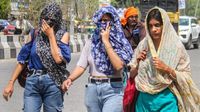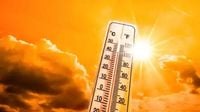Chandrapur, a city in Maharashtra, has become the hottest place on Earth, recording a staggering 45.6 degrees Celsius on April 22, 2025. The India Meteorological Department (IMD) confirmed that this temperature is 3.6 degrees above the normal average for this time of year. The heatwave gripping the Vidarbha region has prompted the district administration to issue a heatwave alert, advising residents to take precautions when stepping outdoors.
Chandrapur's scorching temperature was highlighted by US-based private forecaster El Dorado, which placed it at the top of the global heat graph for the day. Historical data reveals that Chandrapur has previously recorded even higher temperatures, peaking at 47.6 degrees Celsius in April 2013 and 47.2 degrees Celsius in April 2019. This year, the city is experiencing a particularly intense heatwave, with temperatures soaring since last week.
On the same day, other cities in the Vidarbha region also reported alarming temperatures. Amravati recorded 44.6 degrees Celsius, while Akola reached 44.1 degrees Celsius, making them the second and twelfth hottest cities globally, respectively. Nagpur, which had topped the national temperature charts just days earlier with a high of 44.7 degrees Celsius, recorded a slight dip to 43.6 degrees Celsius on April 22.
The IMD has issued a heatwave warning for Chandrapur, Akola, Amravati, and Wardha, with conditions expected to intensify in the coming days. Most districts in Vidarbha are currently experiencing temperatures in the 43-44 degrees Celsius range, with predictions indicating that temperatures could approach 47 degrees Celsius in May, traditionally the hottest month in this region.
Residents have been caught off guard by the sudden rise in temperatures, with many choosing to stay indoors during peak afternoon hours to avoid the oppressive heat. Streets in Chandrapur, Nagpur, and surrounding areas appeared deserted as hot winds blew throughout the day, further exacerbating the discomfort.
In response to the extreme weather, Chandrapur district collector Vinay Gowda GC and Nagpur collector Vipin Itankar have urged citizens to take necessary precautions. They have issued an advisory outlining essential dos and don'ts to help residents cope with the heat. Recommendations include staying hydrated, wearing light cotton clothing, and avoiding direct sun exposure between noon and 4 PM.
As the heatwave continues, wildlife is also feeling the effects. Reports indicate that 91 animals, including birds and reptiles, have been rescued in and around Mumbai due to severe dehydration caused by the oppressive heat. The rescues were carried out by the forest department in collaboration with the NGO Resqink Association for Wildlife Welfare (RAWW). Pawan Sharma, honorary wildlife warden and founder-president of RAWW, noted that cases of wildlife suffering from dehydration have increased significantly over the last five years, particularly during hotter months.
The situation is compounded by the fact that Mumbai and its surrounding areas have been experiencing intense heat since February, with temperatures continuing to rise. The ongoing heatwave, coupled with low rainfall in the region, raises concerns about the environmental and health impacts, especially for vulnerable populations and wildlife.
In Pune, temperatures are also significantly above seasonal norms, with Lohgaon recording a high of 42 degrees Celsius and Shivajinagar at 39.9 degrees Celsius, 1.7 degrees above the normal average for this time of year. An IMD official explained that the region is currently experiencing hot and dry winds blowing from northwestern India, a phenomenon typical in the pre-monsoon period but particularly intense this year.
The IMD has warned that heatwave conditions will persist across parts of Madhya Pradesh, Vidarbha, and Chhattisgarh until at least April 25, 2025. Citizens are advised to stay indoors during peak afternoon hours, remain hydrated, and take precautions to avoid heat-related illnesses.
As the mercury continues to rise, the local administration is keeping a close watch on the situation, ensuring that measures are in place to protect both people and animals from extreme weather conditions. With the heatwave expected to linger, the importance of community awareness and preparedness remains paramount.





